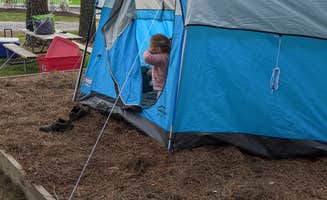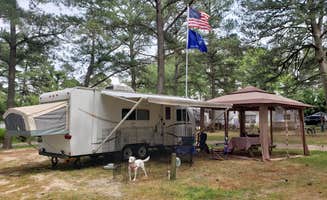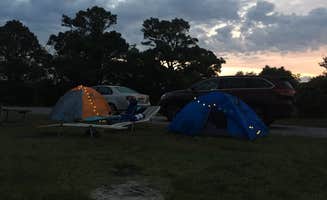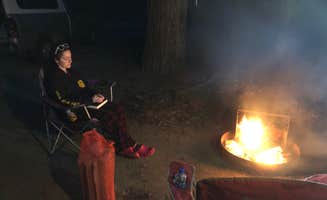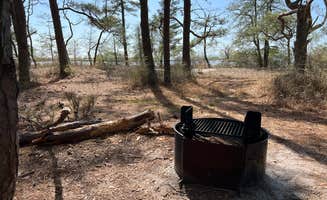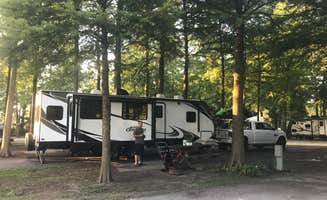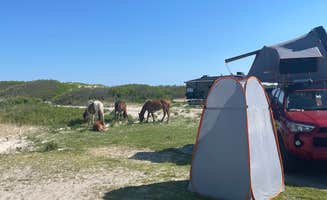Chincoteague Island lies on Virginia's Eastern Shore, separated from Assateague Island by a narrow channel. The campgrounds in this area sit at sea level with minimal elevation changes, making the terrain accessible for most campers. Summer temperatures typically range from 70-90°F with high humidity, while spring and fall offer more moderate conditions between 50-75°F. Most campgrounds report consistent ocean breezes that help mitigate both heat and insects at oceanside locations.
What to do
Beach access points: The Bayside Assateague Campground offers multiple scenic points for water activities. "The beach was beautiful, and you can camp roughly 100 yards from it. Many campsites available, and you can actually see the horses," shares Daniel P., highlighting the proximity to both beach and wildlife.
Kayaking from campsites: At Tom's Cove Park, water access enables unique exploration. A visitor noted, "My husband and son kayaked from the campground over to a lovely sand bar off of Assateague Island. They got within very close range of a herd of ponies grazing at low tide, hung out, and enjoyed their private slice of nature."
Biking to wildlife viewing areas: Assateague Island National Seashore Oceanside Campground provides access to less-traveled beaches. One review explains, "Assateague Island also has TWO bike/hike access beaches, and those are our favorite. You can drive to Assateague from Chincoteague with your bikes, and then park."
Fishing and crabbing: Many campgrounds offer dedicated fishing piers. "We had fun crabbing off the dock with other campers, going into town was very convenient totally within walking distance for ice cream," notes one visitor.
What campers like
Wildlife encounters: Watching wild horses is a highlight at Assateague State Park Campground. "The best thing about this place are the sparkling clean bathrooms with flush toilets and free hot water showers. They also offer sinks with running hot water for washing dishes which makes more ambitious campsite cooking a breeze," mentions Melanie.
Off-season tranquility: Many campers prefer visiting outside peak summer months. "We chose to stay in October with less people and less bugs. Hiking and boys nearby to kayak or canoe at. Beautiful place to stay," says Jodi J. about her experience at Bayside Assateague.
Water access options: Multiple water features appeal to different campers. "What more can you get you have ocean on the right and calm water on the left you can choose what to do," explains Jonny D. about Tom's Cove Park.
Natural soundscapes: Campgrounds near the ocean offer unique sensory experiences. "Falling asleep to the sounds of the ocean is one of the relaxing thing there is. Waking to see wild horses each morning is an experience I'll never forget," shares Paully B.
What you should know
Seasonal bug considerations: Insect activity varies significantly by season. Michael W. advises about Bayside Assateague Campground: "Love this place but be prepared for the bugs. Even enjoyed this in the winter."
Horse behavior awareness: Horses may approach campsites looking for food. "A small herd of them (around 8) decided to hangout in our campsite waiting for their meal. This meant we couldn't get ours. As soon as any food would come into 'nose-shot,' they would start advancing on us," explains one visitor.
Wind exposure: Oceanside sites experience consistent winds. "It is really neat to be able to camp right on the sand dunes and by the beach but prepare for lots of wind. Check the weather a lot because the storms roll in quickly," notes Tori V.
Campsite privacy varies: Site layouts differ across campgrounds. "The sites are very close to each other, but on a less busy week, this is less of a problem as the camping area isn't full," explains one camper about site spacing.
Tips for camping with families
Pool alternatives: Jellystone Park™ Chincoteague Island offers multiple water options. "There is a pool, jumping pillow, and playground. The water park adjacent cost an additional fee. They have 3 day passes and after 3pm packages," notes one family visitor.
Educational opportunities: Many campgrounds offer ranger programs. "The park has programs and we painted a picture of Chuck the Owl (he was our model) which was fun," shares Cindy S. about her experience at Pocomoke River State Park.
Bike-friendly environment: Most campgrounds accommodate cycling families. "Great place to stay with family! Sites are big we fit two large tents on one site. They have a water park down the road and fishing off the pier," explains Amanda S.
Food storage solutions: When camping with kids, proper food storage prevents wildlife issues. "The ponies are giant trash pandas. They're smart and can open latches so do bring bungee cords, kayak straps, or ratchet straps to lock all of your food in cases or coolers," advises Tony P.
Tips from RVers
Site selection strategy: At Pine Grove Campground, RVers find value and space. "Large sites. Staff bends over backwards (let us borrow a length of water hose when ours was too short by a couple feet). They make you feel like family," says Tim S.
Electric hookup availability: Power options vary across campgrounds. "30 amp service available on Acorn Trail and Deer Run. No water or sewer hookups but there is a dump station at park entrance with a water fillup spot," explains Jason B.
Size limitations: Some campgrounds have restrictions for larger RVs. "RV sites are very tight. Anything over 35' in my opinion will be hard to get into sites," cautions one RVer.
Seasonal rates: Off-peak camping offers significant savings. "Also very reasonable. Office is only open about 9-3 but they allow you to 'just find a spot and check in the next morning'," shares Ron H. about Pine Grove Campground.


